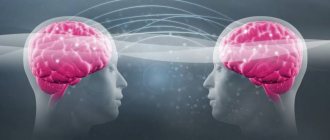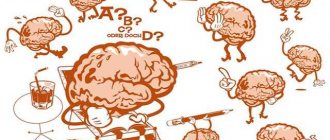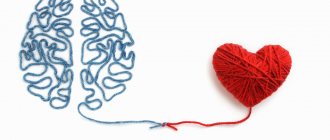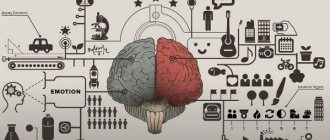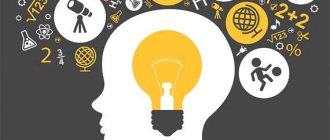Sometimes you can hear about a person: “He is completely devoid of imagination!” Basically they say this about people who don’t know how to fantasize. But is the development of fantasy and imagination really necessary for modern man? Scientists claim that imagination is as important a mental process as thinking, memory, and attention. Without it, there will be no great discoveries and works of genius, inventions necessary for humanity. Life itself will become boring and dull without imagination.
Imagination expands the possibilities of cognition and transformation of the world around us
How to develop imagination and visualization as an adult? Where to start and how to move forward?
“Maria Ivanovna, we urgently need to find a way out of this situation!”
- you hear at work. Or do you come home from work, and your child once again asks to play something interesting? How to use exercises to develop imagination and visualization in an adult in order to become successful and happy? Well, here we are again, twenty-five, but what does success have to do with it? To do this, it is enough to be educated, responsible, and smart. That's how it is. But imagination can give you more.
Everything is very simple. To invent is to create, and creation is always unique. Creative and unique people are difficult to find, much less replace. This is value.
Creativity is possible thanks to the imagination and the right hemisphere. Creative people are needed!
Imagination is:
- creative approach in any field, profession,
- exciting games with children, fun and happiness,
- finding a way out of any difficult situation.
Children cope with the last point very well) Do you want to know what you need to do to restore your imagination? Great! Let's run!
The content of the article:
Proven Formula for Progress
- Ready to test your imagination now?
How to easily develop imagination and visualization in adults?
- How to quickly fill yourself with visual images?
- Revitalizing the right hemisphere
- Simple and useful actions to activate your imagination
- Secret techniques for developing imagination
Where to start developing visualization?
Gulliver's Mystery or how to write fairy tales for children
Techniques for creating images of the imagination
To create an image of an object in the imagination, use the following techniques for creating imagination images:
- Combination . Individual objects or elements are rearranged in such a way that the result is a new unusual combination. This technique is used when writing paintings, books, poems, and making innovative discoveries. To combine objects, do not use a simple mechanical combination of individual sides of the object. A new image is obtained as a result of complex analytical and synthetic activity that transforms elements beyond recognition. This is the method that artists and writers use, adjusting individual elements to fit an existing idea.
- Agglutination . A special case of combination, the essence of which comes down to obtaining a new image by gluing individual ideas into one. An example is the combination of human and animal body parts in a fairy-tale hero. In technology, agglutination found application in the creation of a trolleybus (“gluing” a bus and a tram).
- Accentuation . When creating a new image, some parts of the old are omitted, while others are highlighted. By focusing on color but omitting the size of the item, you can create a completely new item.
- Sharpening . A special case of accentuation. Attention is focused on the height, weight, size of the character or object. As an example, we can use the gigantic growth of giants and the insignificant size of Thumbelina.
- Schematization . When examining objects, differences are erased, individual ideas are smoothed out, and common features are put on display. Used in the creation of scientific and technical objects.
- Typing . In the process of typification, essential and repeating elements are projected onto a separate, completely new image. Synthesis of individual images occurs. This technique is used in the literature.
The use of the above techniques significantly facilitates the task of developing imagination in adults.
Proven Formula for Progress
Remember the words of Albert Einstein? He said that knowledge is limited, imagination is more important, since it stimulates progress and gives rise to evolution.
Once upon a time there were no cups, people drank from their hands, folding them into a boat. And someone thought of making a cup like this.
This genius transferred the functions of folded hands into a drinking vessel. And the cups appeared. People began to use cups, and progress occurred. And so it is in everything that surrounds us.
Here: Games that develop fantasy and imagination - 5 important steps You can read in more detail about the concept of imagination and games with children to develop imagination (will open in a new tab).
Imagination develops the brain!
Why are creative people needed everywhere? Of course, of course, because of their ideas, original approach. All this is true.
But the first and most secret thing is that imagination, as the highest mental process, is connected with many other mental processes.
It is associated with thinking and memory. And by developing one, we get results in these processes. At least three in one. Memory and thinking improve, and the brain develops.
By the way, the best result (at least imagination and creativity) comes from the ideal interaction of both hemispheres of the brain.
Why are children geniuses from birth? Because they have up to 3 and this amazing interaction is observed. And those who preserve it are considered geniuses.
To preserve it in your children, play these games with them and read our article (will open in a new tab).
What about adults? To establish such interaction with you, go through and download the exercise here (link will open in a new window). Plus, it powerfully relaxes eyes tired from being stuck on gadgets.
Ready to test your imagination now?
The task is to find the superfluous. Here are three pictures. Fork, knife, plate. What's extra? What will you remove? Read no further for now. Think, reflect. What's the catch?)
We look at pictures, think, thinking is involved, our concepts of meaning are explored. “Yeah, you can remove the plate, after all, it’s a dish, but a fork and knife are still cutlery.”
Yes fine. That’s what they taught us in kindergarten when they prepared us for school. And here your imagination waves you goodbye)
Why? Because we proceed from the learned meanings of objects. Is there another way? Eat.
Let's use our imagination. What are the forks and knives for? They are needed to eat food. We put the food on the plate. Right? Yes. So there's nothing superfluous here?
But, according to the conditions of the task, it is necessary to remove the unnecessary. What is unnecessary here that needs to be removed?
And this is where imagination comes in. You noticed that we began to think hard, imagine pictures, go through options for combining them, combining them into a plot. This is it, our imagination.
It decomposes the image into parts, modifies it, and then connects it. In scientific terms, these mental actions - analysis and synthesis - are tools of thinking. And it is impossible to separate them from each other.
Therefore, imagination is a powerful thought process that develops our brain, and a child’s brain is better than early development centers).
What answer did your imagination give? Write in the comments.
Well, now let's develop our imagination.
Methods for developing imagination
One of the main conditions for the development of fantasy is the presence of food for the mind: visual, sound and taste impressions.
If you feel that life has become boring and empty, and mental activity is causing fatigue, it’s time to think. Are you bored with your routine? Has everyday life become too predictable? It may be time to find a way to make the switch.
Books
Firstly, the most accessible and enjoyable method is reading books. The main thing is that it is truly effective.
Because while reading, you involuntarily mentally transport yourself to the pages. Some people prefer movies to books.
This also has its reason, but the film closes many questions. You can come up with the plot, but the faces of the characters and everything else have already been invented for you.
However, when reading, you do not have a picture in front of you, and your brain completes all the images.
For example, if a street is described, you will certainly see this street in your mind’s eye. In addition, if a person is being described, you will definitely imagine him somehow. Maybe he will look like someone you know; maybe for someone else. But it definitely won’t remain faceless!
Another advantage of the book is that it can transport you to any time and place. By reading, you push all possible boundaries and truly experience the experiences that form the basis of our imagination.
You will no longer be completely absorbed in the daily routine, it will not put so much pressure on you - because you have somewhere to hide. And there is something to which you can switch your thoughts. Your brain will work in a different mode. He will become receptive to new information.
Associations
Secondly, develop associative thinking. Associations are connections between objects, events, facts and phenomena. By consciously stimulating these connections, you will learn to create a holistic picture in your mind.
Start simple. Think about what you associate with simple everyday objects - a cup, a book, a watch, etc. What memories do they bring back to you?
Then complicate the task: try to mentally change the appearance of objects. For example, change their color. Don't limit yourself to natural shades, allow yourself to think original. Imagine blue strawberries! Imagine what a green scarf would look like if it were checkered yellow. And at the same time, how it would look on you. Analyze, has your perception changed?
It will be useful to use your senses. Think about what specific tastes and smells you associate with - fresh bread, coffee, mown grass, air after a thunderstorm. Focus on these thoughts.
Listen to music. Often songs and simple musical compositions without words stimulate the imagination so much that entire clips are played in your head. Again, specific music can trigger memories associated with it.
Even the above-mentioned books and films can be associated not with their content, but with the events that occurred at the time of reading or watching. Use the prompts of consciousness and give yourself the opportunity to immerse yourself in it.
How to easily develop imagination and visualization in adults?
But first, the second most secret. When we imagine, we operate with images. Therefore, the right figurative hemisphere is responsible for imagination. By the way, scientists have conducted research, figurative memory has no boundaries.
And following the words of the French scientist I. Saunière, by developing the right hemisphere, we develop the entire brain. Now it becomes clear why creative people have excellent memory, sharp thinking, and are so valued everywhere.
It's all about how the brain works. It is believed that a person who can constantly and easily “climb” into his right hemisphere when solving problems has exceptional abilities and signs of genius.
You just need to learn how to operate with images.
Why are children geniuses from birth? Because in childhood, both hemispheres are active and work synchronously. They have excellent imagination, the power of images, and intuition.
By strengthening this in them in childhood, we will give them amazing abilities. If you want to find out how to preserve all this in children, then here you go: Makoto Shichida’s Method for Children. How can busy mothers do it anyway? (opens in a new window).
Now let's start restoring our abilities.
How to quickly fill yourself with visual images?
1. As we have learned, images are very important. You need to fill yourself with images.
Look and memorize paintings by artists and just a lot of paintings and reproductions. Look for beautiful pictures on the Internet. Then try to recreate them from memory.
Why beautiful paintings?
Do you care what you have for breakfast? That’s how beautiful and pleasant things are better for the brain. Because nothing passes without a trace, everything is recorded by the brain and remembered, if not consciously, then subconsciously for sure.
You can go to museums and exhibitions. Imagination is the creation of a new unusual thing from what is in memory, from existing experience. Therefore, we get visual experience.
Revitalizing the right hemisphere
2. Smell
We take any smell. Let it be a carnation. Inhale it, soak in its scent. What do you smell, what does it smell like? Describe it. Now, what does it suggest to you? Just describe the images that arise, take a pen and write.
What about the smell of the ice cream you ate as a child? What is he like? What does it smell like that you remember? Go back in time and play around for a bit. What did you want then?
3. Touch
Here you need to prepare. Find different surface materials. Let it be a soft toy with warm, soft wool. Maybe a white bear?
Run your hand over the toy, bring it to your face, and rest your cheek against it.
What do you feel, what does it remind you of, what is it like? What was your favorite toy as a child? Write what images came to you.
4. Taste
What is your favourite dish? Who cooked it for you for the first time? What kind of dish is this? What does it look like? Imagine that it is lying in front of you, but you cannot eat it yet.
This will make your mouth water a little more. You can't hold back any longer. Eat it. But there is no need to lash out like that. Slowly, slowly. After all, this is your favorite dish. What do you feel?
5. Hearing
Here all the music is to help you. You can turn on your favorite works and be carried away on the waves of your imagination. What do you see, what do you feel? Watch and remember while the music plays. Then write down all the images that visited you.
And in this article you can listen to music that develops the brain, provides relaxation and expands memory: How to use music to develop the brain and memory - personal experience. 5 best songs (opens in a new tab).
Simple and useful actions to activate your imagination
6. Reading
Have you read a book recently? Is this fiction? Are there any heroes? Where did the specific action take place? Mentally remember this place, and then transfer it to paper.
Draw the main character in your imagination. Try to transfer this image to paper.
7. Email
If you read a letter from a stranger in your mail. Try to mentally draw his portrait. Think through all the details. What is his face, hair, eyes, mouth, nose like?
And his figure? How does he sit when he writes? And then imagine the process of writing a letter to you.
8. Did they call you?
You answered the call and heard an unfamiliar voice. Who is this man or woman? What kind of voice does this person have? Pleasant, gentle, rough, low, tall? Try to imagine the person in your imagination.
9. See the invisible, hear what is seen
A very effective exercise. Turn on the sound of a movie (you can start with a familiar one) and turn off the picture. Listen and watch the film from memory.
Now we do the opposite. Turn off the sound, turn on the picture. You are showing a silent movie. You watch and guess what the characters are talking about.
Now we do the same with an unfamiliar film.
10. Imagine your future
Describe in detail: what you want to have, where to live, what to do. What do you look like? No need for one time. Let it take a few days. It is important to think through everything thoroughly and imagine it.
Just don’t need reality) Dream like you did in childhood. Let it finally be what you really want.
And if you want to add a little something to it, embellish it, so be it. Congratulations, your right brain is alive. Give him free rein.
Secret techniques for developing imagination
11. Link two unrelated objects
For example, a dog and an iron.
First imagine the dog, then the iron. Place them next to each other, opposite each other. What are they doing? Why can they be together or can't they? Come up with new unexpected connections and combinations.
Using prepositions will help you. Iron on the dog, iron under the dog, behind the dog, dog in the iron.
What comes out of this? Can you make up a story?
12. Zoom in and out
What if your nose or legs got longer? To happen? Up to the size of the house, imagine this picture. Live in this image for a little while. What good things can be done and what will not be very convenient to do?
Where would you buy your clothes? How quickly would you go to work? What else?
If your height decreased. Would you become very small, like a mouse? What happened to you? What if no one noticed this? Remember Gulliver? The same technique was used in this tale.
Now you.
13. What does it look like?
Leonardo da Vinci could see a bizarre and necessary picture and situation in the spots on the wall. He himself called this method ridiculous and trivial. But it is precisely this method that leads our mind to invention.
Look at the clouds. What images do they remind you of, what do they look like? Now look at the entire visible part of the sky. What happens to the images now?
We can select any object, not just clouds. The main thing is that it is not clear, but requires reflection.
14. What is hidden in the picture?
Famous children's drawings. This is when a zigzag is marked on paper, and you need to complete the whole picture from it.
Take a pencil and paper. Place dots and hooks with your eyes closed, and then try to complete them into a clear plot, image, the whole picture.
Or this picture. Can you find 14 horses?
Imagination and age
Childhood is not the only time when imagination develops. It takes place in several stages:
- Childhood;
- Transitional age;
- Youth.
Each of these three periods has its own characteristics and its own incentives.
In childhood, a child experiences the world as such. Template thinking has not yet formed. Everything happens for the first time, everything is new, everything arouses curiosity. The brain works very quickly at this age. This is how it is laid down by nature itself. At the same time, the child does not yet have knowledge about the world around him.
A fairy tale seems as real as everyday life. He does not analyze, but simply takes everything on faith. E.E. wrote in detail about imagination in preschool age. Kravtsova.
A teenager thinks differently. He is looking for his place in the real world. His imagination relies on the present, but at the same time draws pictures of the future. Dreams become an important component of thinking. Sometimes crazy and naive, but already rational.
Adolescence poses different challenges for a person. And he himself is already different - with more or less established views, more stable, more erudite. He is able to look into the distance and think creatively, freely, without forcing himself into boundaries. In adulthood, this ability may decline under the pressure of unfavorable circumstances.
Where to start developing visualization?
Visualization is the ability to imagine, to see an object on the internal screen with eyes closed or open.
How are visualization and imagination related? We can imagine somewhere in our heads, using images, and the ability to clearly see them on the internal screen is visualization.
A special variant of visualization is photographic memory, when the memorization or image of what was seen looks like a photograph. During visualization, images can move, live, and also have other modalities (sound, smell, sensations).
How to learn to visualize, to see images? Japanese professor Makoto Shichida, who has a whole right-hemisphere technique, advises using afterimages to develop the power of images.
This is not the only exercise, but it is the simplest. Read about the technique in our article Makoto Shichida’s Method for Children. How can busy mothers do it anyway? (opens in a new window).
And also in the article How to develop photographic memory quickly (opens in a new window).
We will follow his example.
15. Using afterimages
Take any simple picture. Or draw your own red or blue circle on a white background. Print and look at the picture for 5-10 seconds.
You may need more time, but no longer than 30 seconds. Then close your eyes and observe the afterimage of the picture.
It may appear more than once, but after some time. Repeat this exercise as often as possible.
The goal is to see a red circle like the picture on the mental screen with your eyes closed.
Development of creative imagination
Creative imagination is a type of creative activity of consciousness, during which the formation of completely new images and ideas occurs. In this case, existing ones can be taken as a basis.
Important! The development of imagination is impossible without reading books, replenishing your vocabulary, and making associations.
If you don’t have time for this, you can do the following exercises to develop your imagination:
- Letters . They choose any letter from the alphabet, after which they name all the objects in the room that begin with this letter. By exercising regularly, you can not only develop attention and memory, but also imagination and thinking. The missing items can be imagined.
- We name and describe . Choose any picture you like and try to name and describe it yourself. The same exercise can be applied to people and objects. It allows you to develop not only creative abilities, but also the basics of creative thinking.
- Geometry . Find geometric drawings and try to name the objects that they are trying to depict with their help.
Gulliver's Mystery or how to write fairy tales for children
Oh, they are very easy to compose. We have already learned what technique was used by the author to compose a fairy tale about Gulliver. If you remember fairy tales, it can be seen in many other fairy tales and stories.
You can take it into your piggy bank. But what other secret is there?
The most important thing is to recognize that everything in the world is alive and can live its own life. Not even living things. We must agree that in fairy tales everything is possible.
Once you accept this, everything will change. Let's exercise our imagination and take... a stone.
I will offer an option, and you create your own.
A stone can have its own life, children, wife, etc. Or maybe he is still lonely and looking for a soul mate? And he comes across them as gray pebbles.
And suddenly he saw the one and only one - it was an elegant fragment of granite. It sparkled in the sun. When the pebble passed her in small steps, his heart beat in his chest so that this knock could be heard.
And he decided to invite her for a walk. But suddenly the unexpected happened... What happened?
Our heroes did not meet, but… stood in their way. What happened next? What did our loving pebble do? Who helped him? What obstacles did you have to overcome? How did it all end?
Imagine the pebble, his lover, the whole plot and write it down. But, of course, the ending should be happy)
Books that develop imagination
Many rationally thinking people refuse to read books written in the genre of science fiction and fantasy, and do not read fairy tales and stories where the author deliberately lies. They believe that such reading is intended for children and adolescents and is unworthy of an adult. In reality this is not the case.
Fairy tales and interesting fantasy stories help develop imagination not only in children, but also in adults. If reading something like this is not interesting, you can study one of the following educational books:
- "Six Thinking Hats" (Edward de Bono);
- "A Beautiful Mind" (Michael Michalko);
- “Methods for the development of memory, imaginative imagination, thinking” (Igor Matyugin).
Interesting, but far from scientific works that allow you to significantly expand the limits of the reasonable, are books for the development of imagination by the following authors:
- Stephen King;
- Joanne Rowling;
- Michael Crichton;
- Patrick Suskind;
- Michael Bulgakov.
It is worth emphasizing once again that reading science fiction helps develop imagination to unprecedented proportions. This is why small children so easily make up funny stories about their toys, parents, and friends, while adults find it difficult to do this. In childhood, everyone fantasized, but as they grew up, they forgot about this ability.
A person may well exist without imagination, but the ability to recreate new images and ideas is never superfluous.
Types of imagination in children
For most people, imagination and fantasy are identical terms. But this is not entirely true.
Fantasy is a fictitious situation or image that has no relation to the real world. A striking example is talking animals, the tooth fairy or the underwater kingdom.
Imagination is much closer to reality and is even based on it. The term “imagination” refers to the child’s ability to form real images, situations in his mind and control them. They do not contradict reality, they are its continuation. A child can imagine how he will play with a donated dog, how he will become a successful scientist or athlete. Thus, fantasies are the idea of what cannot happen in reality. Imagination is the representation of very real things.
Comparison table between fantasy and imagination:
| Fantasy | Imagination | |
| Present tense | A situation or image that is far from reality | A situation based on real events, but further developed by the child |
| Future | Remains fiction | May be implemented in the future |
From the point of view of experts, imagination matters more. It is considered as the child’s creativity, creativity, and his ability to simulate situations that are close to reality. But is all imagination the same? There are three types of it:
- Recreating, when the baby models situations related to what he heard, saw, read.
- Uncontrollable, when the modeling of a situation is contrary to the laws of logic, the sequence of events.
- Creative, when the child independently creates situations, images, stories.
It is believed that creative imagination is the most important. It is tightly intertwined with fantasy, and it is these two areas that need to be developed in a child. In the future, this will allow the baby to:
- Think about actions, make decisions taking into account possible consequences.
- Solve non-standard life problems, find a way out of unpredictable situations.
- Adapt to society, take your place in it.
Despite the fact that fantasies are considered ordinary fiction, they have a positive effect on the development of the child and are a source of inspiration and joy. It is important to encourage imagination, but make sure that the child does not become isolated in his own imaginary world.
Why is it necessary to develop fantasy and imagination in children?
Children's fantasy and imagination are very important for creative development. They say: “Without imagination there is no consideration.” A. Einstein considered the ability to imagine higher than knowledge, because he believed that without imagination it is impossible to make discoveries. K. E. Tsiolkovsky believed that cold mathematical calculation is always preceded by imagination.
Sometimes in everyday life fantasy and imagination are understood as something empty, unnecessary, lightweight, and not having any practical application. In fact, as practice has shown, a well-developed, bold, controlled imagination is an invaluable property of original, non-standard thinking.
It is difficult for children to think “according to the laws,” but if they are taught to fantasize and not be criticized for it, then children fantasize easily and with pleasure, especially if they are also praised.
Apparently, this is how children subconsciously learn to think - through play. We need to take advantage of this and develop imagination and imagination from early childhood. Let children “invent their own bicycles.” Anyone who did not invent bicycles as a child will not be able to invent anything at all.

